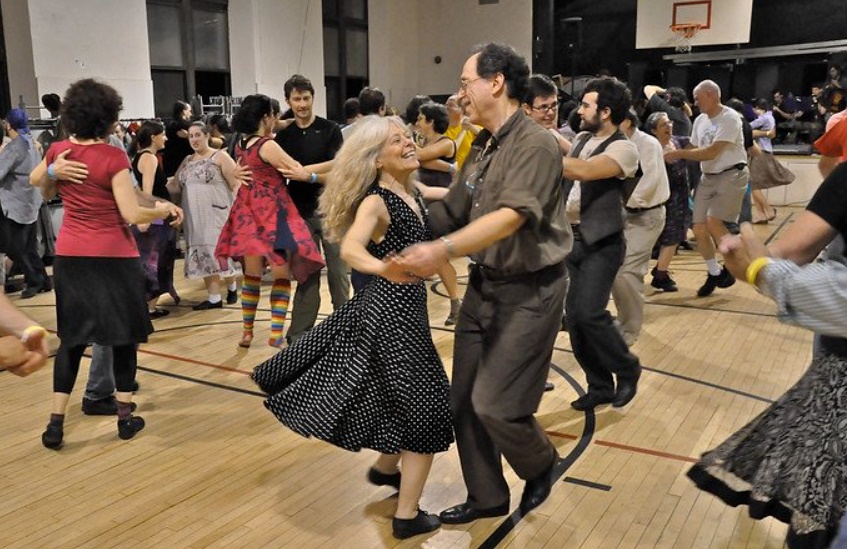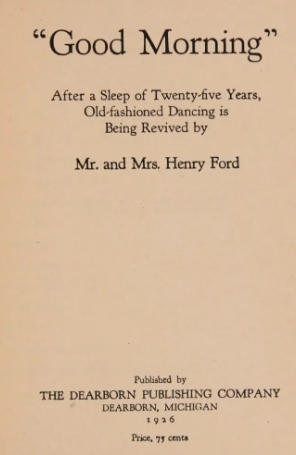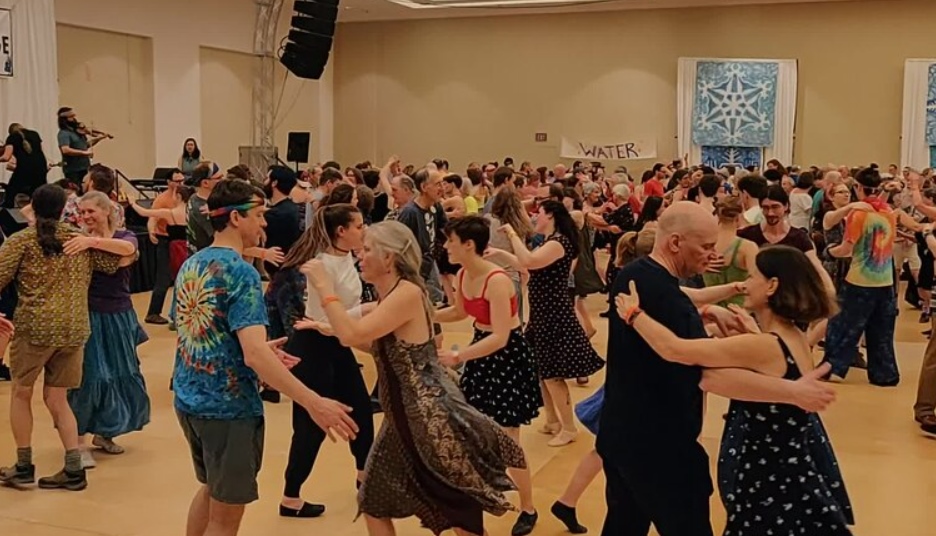The Contra dance is a folk dance with mixed origins and styles from England, Scotland, and France. It traveled across the ocean and became much more popular in America and most English-speaking countries.
A significant feature contributing to Contra’s popularity is how open it is. Even if you don’t have a partner, you are welcome to join. The footwork is not fixed, hence many people can learn the dance on the spot.
Table of Contents
Origin of Contra Dance
Early History
Although Contra is a very popular social event in the United States and neighboring countries, it has a European origin that we need to dive into to learn better.
When the 17th century approached its end, dance masters from France were infiltrating the country dance scene of English like a flood. In their language, “country dance” sounds quite similar to “contredanses”.
As these dances came back to England and traveled to America, the name was retained, alternating between “country dances” and “contradances”, depending on the regions, yet the similarities in pronunciation explained why it is called Contra dancing.
In America
In the later decades of the 18th century, social dances were widely popular in America, regardless of class, and Contra dances were always at the top of the popularity chart.
Half a century later, these group dances were slowly replaced by couple dances such as quadrilles, polka, or waltz. Eventually, before the next century came, Contra had already retreated to rural areas.
During the 1920s, the United States was under the heavy influence of modern jazz, and not every American was fond of it. Henry Ford (the one and only Ford behind Ford Motor) led the objection and revived square dancing.
Ford sought help from Benjamin Lovett, a friend and dance coordinator, for a dance program focusing on folk dances, and Contras were included.
Following this move, the business magnate published “Good Morning: After a Sleep of Twenty-Five Years, Old-Fashioned Dancing Is Being Revived” in 1926, describing Contra dance moves in detail.
Check more: All About Courante Dance: Origin, Types, Steps & More
Modern Contra Dance
Unfortunately, the wave of big jazz and swing bands still came out on top in the end. Contra was reduced to the northeastern regions like New England, Canada’s Maritime provinces, and Ohio in 1930 – 1940.
New England was the promising land for Contra during this era, and the tradition was magically maintained by one man: caller Ralpha Page.
Dudley Laufman and Ted Sannella followed his path and revitalized Contra, turning themselves into important figures in the revival of this dance.
The tradition in New England also thrived in Vermont with the establishment of the Contra group founded by Edwin Loyal Larkin (1934). They are still hosting classes and open-house dances today.
The middle of the 20th century witnessed the birth of retreats and dance camps, which gave people the opportunities to gather and partake in Contra and other dance styles as well as various activities.
Ted Sannella pioneered a trend of callers who refreshed Contra with new moves from country dances of England and various formations such as double progression (by Herbie Gaudreau), quadruple progression (by Gene Hubert), or the Becket formation.
Events
You can find Contra dances most easily in hundreds of towns and cities across America and neighboring countries. These events have no restrictions on age or gender, so everyone can attend.
In most cases, the caller will give basic instructions, so even beginners won’t have any trouble catching up before the three-hour main event starts.
However, that isn’t to say you will dance for three hours straight! The duration is divided into a series of 15-minute individual dances with band performances at intervals.
If the event takes place in the evening, the chance of seeing a live band will be much higher. The repertoire is as broad as going from compositions of the previous century to modern tunes, hence the range of instruments is also extremely extended.
Before the event officially begins, you will typically have a caller showing you the walk-through so you know the instructions they will be making later. The calls will most likely be given throughout the first few sequences and the last.
Also, you don’t need to find a partner to attend a Contra event. Socializing is an essential part, hence dancers are highly recommended to invite new people to dance with them.
Be warned: Many venues don’t encourage you to hog or reserve a partner too ahead of time!
Everyone has to start from somewhere. Experienced dancers were once beginners, so keeping an open mindset and being helpful to newbies is a must.
These friendly policies are sometimes unfortunately abused, and venues have become more cautious with their rules too.
Performance
In a social dance, cooperation is key to success. Contra is not an exception.
If you follow the course, you will be interacting with other people aside from your partner. The event, then, will become a group activity, hence you will learn to work with the entire circle.
Formations
The couples in Contra dances will form long lines, two lines are equal to a set. This means you can have many sets in a hall.
A set has the top and the bottom. The “top” is closest to the band and the leader. The “bottom is farthest from them.
A couple is traditionally made up of a male and a female, yet gender no longer matters. You might find different ways to refer to the two partners in a couple: ladies – gents, jets – rubies, larks – ravens, and men – women as well.
In each round, a couple is expected to interact with the neighboring pair, and they will form a minor set (or hands four). The actives are above and the inactives are below.
If the pairs are an odd number, the last couple will wait through the first round.
The minor sets can be arranged in several ways:
- Proper: All males are in one line, and the other line is all females.
- Improper: Each line has both males and females alternated.
- Becket: A couple lines up and faces another pair.
- Triples: Involving three pairs instead of two.
Progression
Besides the friendliness and the openness in Contra events, interactions with various participants are a crucial aspect too. The act of getting yourself associated with different neighbors is progression.
The pattern you need to follow to achieve progression is introduced and explained by the caller, typically repeated until everyone is comfortable and confident enough.
If you look at the whole room, all couples are in sync with the pattern. But, they also take turns moving toward and away from the band and the caller. So, their neighbors will always change. When a couple reaches the end, they dance back in the reverse direction.
The number of participants can vary from 30 to 300 between smaller towns and larger cities. If the set includes over 60 individuals, you can’t dance with everyone in a single round!
Moves
For Contra and social group dances in general, the participants will follow the guidance of a leader. Before the music is on, the leader will describe the basics to the newbie, and sometimes ask veteran dancers to demonstrate the moves.
During the performance, you are expected to listen to the caller and execute the moves they prompt. It often follows a pre-informed order. But, if not, the caller will notify you in advance.
Following the formation, the choreography of Contra dance tends to have 6 – 12 figures arranged in a pattern with grace and flow. The caller needs to prompt the figures in time. The most commonly seen figures are described below.
Allemande
The duo join the same hand with the thumbs up and the palms pressed together.
Balance
This figure often precedes a swing and takes 4 counts. Most variations include stepping on one foot and kicking the other while holding hands with your partner. Moreover, it can be done in waves or circles as well.
Butterfly Whirl
The dancer holds their partner’s waist and turns around to face the same direction. The female will walk in a circle forward and the male backward, leading to the female in the center.
Afterward, the male can do an allemande, drop his hand, and the couple return to the original position.
Circle
A format of four dancers moving to the counts in a clockwise or counterclockwise circle.
Contra Corners
A format of six dancers with a couple being the active pair and the other four in four corners. The active couple will have to alternate between Allemande and switching to the corner.
It requires experience in positioning, hence it might not be suitable for beginners.
Courtesy Turns
The couple join their left hands. The male reaches his right hand behind the female’s back to hold hers.
Both of them turn around and remain side by side as the male moves backward and the female moves forward.
Cozy Line
A line with four dancers, two of them become the center and join hands while turning away. At the same time, the other two turn in and join hands behind them.
When the outer couple lifts their hands and the inner couple ducks their heads, they can easily shift into the Clover Leaf format.
Down the Hall Four in Line
Two pairs form a line by joining hands and moving away from the music source.
Figure 8
Two people stand while others pass through and move around them in half or full figure 8.
Gypsy
The couple locks eyes and circles each other without any physical contact. It is inspired by country dances in England.
Hey For Four
In a set of four dancers with two parallel lines, each dancer will perform turns and passes to the other line and back.
All of them will move at the same time, hence they need to be in sync and smooth. Embellishments are optional.
Ladies Chain
From the center, the females will join their right hands and pull themselves to the opposite side. So, they exchange partners and give a courtesy turn before returning to the original position.
Pass Through
Two dancers face each other and move along (or across) the set, their shoulders passing but not touching. It usually serves as progression so another couple can be the first in line.
Promenade
The couple faces the same direction as the female on the right and walks to a spot assigned by the caller. They can hold hands in different manners and end the figure with a spin. It is usually a means of adjusting the position of dancers.
Sashay
Two dancers join both hands and move their feet sideways in their desired direction, close, and go for the next step.
Turns
Contra dance may include various kinds of turns, from solo to couple. Dancers can use turns to swap positions or interact with someone besides their fixed partner.
Attires
As casual and open as Contra is, the events don’t have any dress code most of the time. You don’t need special and extravagant clothes, yet your outfit shouldn’t be too skimpy either.
People who are already familiar with Contra events often go for comfortable pieces that allow them to move smoothly. Most women feel better in skirts and dresses, while men have the choice of kilts as well.
Furthermore, shoes are always important when dancing. So, some events will require you to wear shoes and sandals with low or no heels, non-marking soft soles, and broken-in shapes.
Backup clothes are up to you yet highly recommended in case you sweat profusely or your outfit has a tear.
Music
For Contra dances, the music played often has French-Canadian, Scottish, or Irish origins, though it can also extend beyond the limits.
The anchor of a Contra music band is the fiddle, sometimes flourished with piano, guitar, mandolin, accordion, and flute. Depending on the area and the event, brass or percussion instruments might also come into play.
Before the 1970s, each round of the event featured one tune throughout the duration, but the musicians gradually combined a couple of tunes instead, thus giving the performance more variety.
Some notable Contra bands in recent years include Great Bear, Elixir, The Stringrays, Buddy System, The Syncopaths, and more.
Some of them incorporated modern genres into the performance and subsequently paved the way for various dance styles to be infused into Contra dances.
Final Words
Done by all individuals and to live music, Contra dances always promise a boisterous event, a gathering for people of all ages and genders.
At first, you might be wondering “How do they dance with people they have never met before?”, but you will realize how beginner-friendly the moves are and the way formations progress. You will certainly enjoy the performances!


